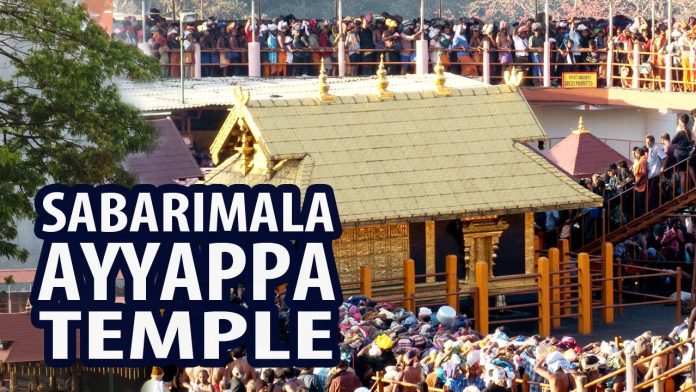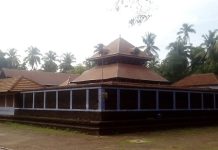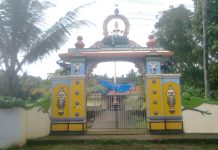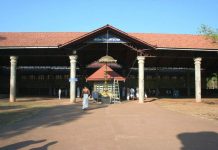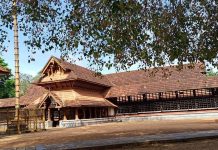As the rains subside, the green fields, valleys and mountains of Kerala echo to the loud chanting of ‘Swamiye Saranam Ayyappa’. The very sight of men and children, fresh from an early morning bath, clothed in black, making their way to the temple invokes a deep, spiritual, peaceful feeling in our minds.
As the ocean was being churned, Lord Vishnu, in the garb of beautiful Mohini, appeared, to entice away the Asuras; and then Lord Shiva succumbed to the charms of Mohini. From that Union was born Ayyappa, hence, the name Harihara Putran.
He descended to the world in the name of Manikanta. Found on the banks of river Pamba, He was brought up with love and care by the king of Pandalam. The story goes that the Queen, who was earlier childless, did not want the Lord to be anointed as the king; but, wanted her own offspring to ascend to the throne. She asked Him to get leopard milk from the jungle. He dutifully went, with his bare essentials on His head; and came back astride a tiger, carrying the leopard milk. The King realised that this was the very Lord Himself. The pilgrimage to Sabarimala is unique in many ways. First and foremost, is the vritham of 41 days, observing strict abstinence from mundane pleasures, frequently taking the name of the Lord. Total surrender to the Lord and seeking refuge in the Almighty. Remember the famous sloka in the Bhagavad Gita, ‘Sarva dharma parityajya, mamekam saranam vraja’ (forsaking everything, take refuge in Me). You also have to be barefoot throughout. The long arduous journey itself through mountains and forest is demanding. Nowadays three routes are available. The most difficult one is the trek via Erumeli. But, via the popular route, you could go by vehicle to the Pampa river and then cross the Neelimala mountain. You also have to carry the Irumudi on your head, the two-compartment cloth bag, the front compartment for the ghee
filled coconut and the rear for the essentials during the journey. This is symbolic of the necessities carried by the Lord when He went for the leopard milk.
Also unique are the eighteen steps leading to the Sanctum Santorum. Only those who have undergone the 41-day austerities and carry the irumudi can climb these steps. The first five steps represent ‘Panchendriyas’, which are the five human senses. The next eight steps represent “Ashtaragas’ which includes Kama (desire), Krodha (anger), Lobha (inordinate desire), Moha (attachment), Madha (pride), Matsarya (unhealthy competition), Asuya (jealousy) and Dhumb (braggy). The next three steps represent ‘Thrigunas’ or the three qualities of Sathva, Rajas and Thamas. The final two steps indicate Vidya (knowledge) and
Avidya (ignorance of knowledge). The pilgrim conquers these steps and then is granted a darshan of the Lord. The Lord Himself, is seated in Padmasana, facing East, with His left arm resting on His left Knee. As a Temple, it is not as vast, nor, does it have the architectural splendour of many other temples, but the religious fervour in the pilgrims is rarely seen anywhere else.
During the period of austerities, and during the pilgrimage, all are equal, all are Ayyappans, all look alike also. You have to surrender your ego to the Lord. There is no difference due to status, wealth, caste or even religion. One of the most ardent followers of Swamy Ayyappan is the famous singer Yesudas, himself a Christian. Before you pray at the main temple, you can pray at the shrine of Vavar, a Muslim saint. Pilgrims who pray at the Temple almost always go back for repeat pilgrimages. It is estimated that, before the women entry controversy and the pandemic, about 40 million people visited the Temple every year. In fact, if you go to almost any part of Kerala, during the season, you will see numerous pilgrims, going to or coming from Sabarimala
The Temple opens for five days every first of the Malayalam month, then during the Mandalam season in December, and again for Makaravillaku in January. The occasion of Makara Sankranthi in January is considered very auspicious with many ceremonies and ends with you sighting of the Makaravillaku, the celestial light. The customs and traditions of the Temple at Sabarimala has, on a few occasions, given rise to some controversies. The source of the Makaravillaku was once debated at length. Recently, the non-entry of ladies in their reproductive age was yet another controversy fuelled, partly, by a Supreme Court decision. But then religion is essentially a Faith, and who can explain or question a Faith.


























